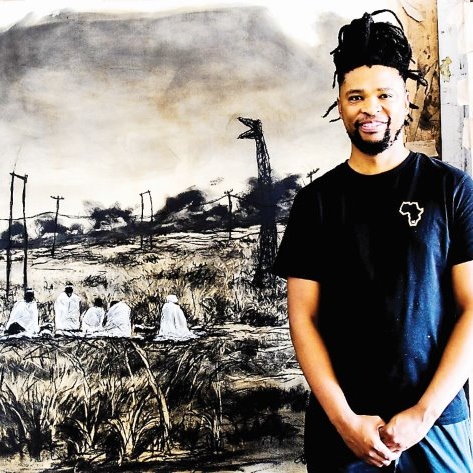
News

The August House of artistic possibility
HOWARD SACKSTEIN
This was years before Makamo would grace the cover of Time magazine and become the darling of American late-night TV talk shows. “The area was derelict,” says Mayers, “the building opposite was hijacked, and this was one of the most dangerous parts of town.”
August House had been the original home of African Sales, the French perfume and fashion empire started 82 years ago by the Priebatsch family, but had long since been deserted.
When Mayers arrived at Makamo’s studio, he discovered that Makamo was in the process of being evicted. The then owners of August House, desperate to sell the building and flee the dangers of the inner-city, were attempting to evict the tenants as a prerequisite for its sale.
Realising that there were already a number of talented emerging artist studios in the building, Mayers decided to buy the property and turn it into a vibrant artist colony. It was the continuation of the vision of Bie Venter and Maria Svane who initially conceptualised the idea in 2006.
Today, August House hosts 50 of the most successful emerging artistic talents in South Africa. Foreign dignitaries and the embassy crowd dot the hallways and carry away, under their arms, some of the best artwork produced on the African continent.
Many of the most successful artists in the building are graduates of Kim Berman’s Artist Proof Studios (APS). More than anyone else in the country, Berman has devoted her life to training young artists to be self-sufficient and successful in the professional, cut-throat world of drying paint. Berman’s protégés in the art deco building include Nelson Makamo, Cromwell Ngobeni, Themba Khumalo, Lindo Zwane, and Solomon Omogboye.
“These artists are flying,” says Berman. “At Artist Proof Studios, we give them a four-year scholarship, we pay for them to do a two-year internship, and we buy them materials and supplies.
“Many of these artists have now left the nest and are building really successful careers. It’s a mark of our success and a mission fulfilled. If they come back and print for us at APS, we get the benefit and they pay it forward, it’s a cycle of beneficiation.
“Many of these artists”, says Berman “are making a living, in fact, making much more than a living.” Berman refuses to be drawn on her favourite graduates resident in the commune. She first met Makamo when he was a “shy, lost young man and today he is an example to so many”. When pushed, Berman describes Ngobeni as potentially the “next hot young artist”.
Ngobeni produces emotive pieces like no other artist in South Africa. His stark charcoal and pastel drawings of dehorned rhinos and the exhilaration of youth haunt the viewer.
Karen Moyal and her husband Patrice have been regularly visiting August House for the past three years. “I was taken to August House by my mom for the first time in 2016. I was introduced to Solomon Omogboye and we ended up buying our very first piece of art from Solomon that weekend. From then on, we’ve been hooked,” she says. “Solomon Omogboye produces some of the best large-scale portrait work ever seen in the country.”
The Moyals have collected more than 50 artworks from different African artists, mainly from August House. “For me, what makes August House such a special place is that the prospective buyer is introduced not only to the artwork, but to the artist him/herself. In so doing, this creates an interaction and a connection that doesn’t exist when buying art from a gallery,” says Moyal. “It’s my connection with the artist that makes the piece I am buying from them that much more meaningful”.
Her favourite artists include Omogboye, Khumalo, Andrew Ntshabele, Azael Langa, Greatjoy Ndlovu, and Arlindo Maunde. “We have many of their works. But we’ve just discovered Cromwell Ngobeni, Petros Mwenga, and Jan Tshikhuthula, who are also amazing. All these artists produce work that, for me, conjures up real emotion and feeling”.
Khumalo’s new series of African women at prayer and his moody dark charcoal drawing of cars on a highway at night are nothing short of breathtaking. Tshikhuthula, who is signed with the Everard Read Gallery, produces dramatic landscape images replete with colour-filled trees, dancing windmills, and brooding skies.
Among the flecks of spilled paint and the pungent smell of glue, other talented artists to look out for are Nigerian Sanusi Olatunji, who conjures up magnificent works using a mosaic tapestry of colourful cloth, and the majestic oversized canvasses of the enormously talented Bambolwami Sibiya.
Lauren Woolf, the former marketing director of Ogilvy & Mather and present-day entrepreneur, mentors four artists including the incredible Zwane. She describes herself as Zwane’s “champion” mentoring him in business, marketing, negotiation, and looking for commissions for his work.
“I am there,” says Woolf, “because so many of these young artists haven’t had the benefit of the type of education that prepares them to be self-sufficient artists in the real world. I consider it a privilege to work with them and offer whatever skills I have, particularly through the lens of marketing. I help to get their stories out there. My life is enriched by my involvement in theirs”.
In the Renaissance period, the Medici family became patrons to some of the most famous artists and thinkers western civilization has ever produced. Without the patronage of this Florentine banking and ruling family, we may never have known the names of Leonardo Da Vinci, Michelangelo, Machiavelli, or Galileo.
One has to wonder who the Medicis of the Johannesburg art scene will be in the future.
- Look out for August House’s open day in the first few months of 2020.




